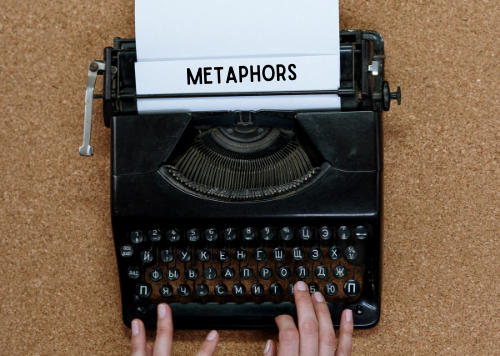A metaphor is a literary device that can make writing more evocative. Fiction writing would be nothing without a smattering of figurative metaphors!
In the basic sense, a metaphor is a figure of speech that describes an object or an action in a way that isn’t literally true, but uses comparison or symbolism to explain the idea. So, a metaphor states that one thing is another thing and compares those two things using symbolism in a figurative manner. Metaphors represent abstract concepts through beautiful, colourful language.
Take a look at these examples.
|
Metaphor |
What it means |
|---|---|
|
Love is a battlefield |
Falling in love or being in love is not always rosy. There are difficulties and challenges as well. |
|
Apple of my eye |
Someone you are very fond of or cherish above others. |
|
A diamond in the rough |
Used to indicate a (good) person who lacks manners, education or style but has the potential to overcome such shortcomings. |
|
Feeling blue |
To feel sad. Blue is often associated with sadness, which is why it's also used in the idiom "to have the blues." |
|
Eyes were fireflies |
Fireflies symbolize hope and inspiration. So it could mean that someone’s eyes looked really hopeful, excited, and alight with possibilities. |
|
couch potato |
a person who takes little or no exercise and watches a lot of television. |
Metaphors and similes often get confused for one another. Similes are like metaphors but metaphors are definitely not similes. While a simile states that one thing is like another (by using the words ‘like’ or ‘as’) a metaphor states that one thing is something else.
George Lakoff, an American cognitive linguist and philosopher, best known for his thesis that people's lives are significantly influenced by the conceptual metaphors they use to explain complex phenomena said, “Metaphor is pervasive in everyday life, not just in language but in thought and action. Our ordinary conceptual system, in terms of which we both think and act, is fundamentally metaphorical in nature”.
Metaphors can make ordinary things extraordinary. We are so habituated to listening to the same words and phrases over and over again that when we hear or read a metaphor, we perk up and take notice. And sometimes, some special metaphorical lines remain with us for a long time!
Here are some famous metaphors that have stood the test of time.
1. “All the world’s a stage, and all the men and women merely players. They have their exits and their entrances.”
~William Shakespeare
2. “Conscience is a man’s compass.”
~Vincent Van Gogh
3. “Art washes away from the soul the dust of everyday life.”
~Pablo Picasso
4. “All religions, arts and sciences are branches of the same tree.”
~Albert Einstein
5. “All our words are but crumbs that fall down from the feast of the mind.”
~Khalil Gibran
Cinema is one medium which commonly uses metaphors, in terms of character depiction, costumes, dialogues and imagery. Bollywood’s big starrer movie Mohabbatein is a beautiful movie of parallel love stories between three couples. The dialogues from the movie are still afresh among fans. Here is one such popular dialogue from the movie in which a metaphor can be spotted.
“Mohabbat bhi zindagi ki tarah hoti hai ... har mod aasaan nahi hota, har mod par khushi nahi hoti ... par jab hum zindagi ka saath nahi chhodte ... phir mohabbat ka saath kyun chhodein”. (Love is like life ... every corner is not easy, every corner doesn't bring happiness ... but when we don't leave life alone ... then why should we leave love alone)
If you go down your memory lane of your all-time favourite dialogues and songs, you are sure to find many metaphors. Now, you don’t have to be a film’s protagonist to say something metaphorically beautiful. You can use metaphors in your daily vocabulary to make your speech interesting. You can be original about it too. It’s an art form and you should practice it often to get good at it.
There are many metaphors that are very commonly used such as raining cats and dogs; (someone) is/are my sunshine; apple of my eye; heart of stone; walking encyclopedia; and time is money. In order to make your written or spoken communication stand out, use metaphors that are beyond the ordinary or the cliched ones. Also, avoid mixing up metaphors and keep your audience in mind to ensure that your metaphor is understood and appreciated by them.
So, how does one create original, fantastic metaphors?
Here are three simple steps to follow :
1. First, decide on the person, item or situation that has to be compared to something else
For example, if you want to compare life to a dancer, think about a dancer’s defining characteristics. The defining qualities of a dancer would be grace, fluid movements, a strong sense of rhythm, and an appreciation of music. So, when you are trying to compare a character, object or situation with a dancer, use your senses and emotions to find the connection between the two. For example: Although I was nervous, my first day in the office was a beautiful, choreographed dance. The metaphor conveys to the reader that although the writer was nervous about his or her first day in the office, the events of the day went off as smoothly and without hitches as a choreographed dance.
2. Emphasize on a particular emotion
A metaphor can be used to bring out various emotions. Let’s go back to dance metaphors. ‘Dancing to someone’s tune’ means being under someone’s control while ‘I will dance on every galaxy’ means freedom and joy. When selecting words for a metaphor, think about the emotion you want it to convey and then pick the right words.
3. Keep it simple
Metaphors don’t have to be long and complicated. Keep them short and simple. Get to the comparison as quickly as you can. Go back to the main idea you want to convey and find the most powerful comparison to convey that.
Well, there are no particular rules to ace the metaphor game. There are only suggestions. Get your creative juices flowing and associate freely. Follow your instincts and use your experience. The most popular metaphors are popular because they're relatable to the masses. It’s nothing but two simple things connected to each other, like time and money. While time and money are two different things, think about the powerful image they create when put together.
Now go ahead and try to work on a metaphor that can fit your life or journey or anything that interests you. Begin with something personal as it can be easier to kick start with that. Remember, metaphors are magic! (We had to end with a metaphor, of course.)
Stay tuned to know what's next in our ‘Vocabulary Matters’ series and join our community - Because Learning Matters to get your weekly vocabulary dose!


Comments